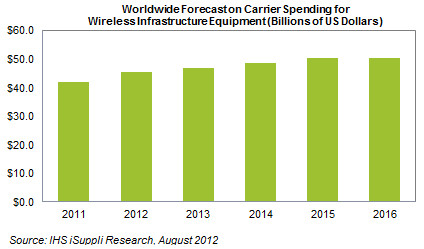Barely five years after Google's Android appeared on the market in 2008, IHS forecasts that cumulative global shipments of smartphones using the OS since it was introduced, will amount to more than 1 billion in 2013. Worldwide annual unit shipments of Android phones will rise to 451 million in 2013, up from 357 million in 2012, according to IHS's Wireless Communications Smartphone Report. The massive totals mean that combined shipments for every year since the first smartphone using Android shipped in 2008 will reach 1.1 billion by the end of 2013. Number-two, Apple's smartphone iOS, will reach 527 million in cumulative shipments in 2013 and will not attain the billion-unit level until 2015. Android's annual growth is set to continue expanding at double-digit percentages in the coming years, will see cumulative shipments will approach 3 billion in 2016. "Androids are taking over the world of smartphones," said Daniel Gleeson, mobile analyst for IHS. "We expect the Android operating system to become the first to reach the milestone of 1 billion shipments during its lifetime. For Google, this accomplishment highlights the success of its growth strategy for Android, which is based on providing the operating system as an open-source platform to third-party smartphone brands free of charge. Google hopes to make significant revenues from mobile advertisements and other services. Such an open-source model means that Google offers handset makers the ability to customize Android easily, and by also eliminating licensing fees, is greatly encouraging adoption among smartphone handset manufacturers." Major brands that are selling Android-based smartphones include number-one-ranked Samsung, second-ranked HTC, and other competitive brands such as Sony, ZTE, Huawei, Motorola, and LG.

Apple's and Google's strong emphasis on a meaningful user experience coupled with new software business models has dramatically altered the competitive landscape for smartphones. The combined share this year of Apple and Google smartphones will amount to a formidable 76% of the market in 2012, with the remaining portion split among four other segments: Microsoft's Windows Phone, Nokia's Symbian, Research In Motion's BlackBerry, and other platforms such as Samsung's Bada and Linux. Prior to the explosive growth of the Apple and Google smartphone platforms, cellphone manufacturers had relied on specialized third-party operating system providers like Symbian and Windows Mobile to provide the core software technologies in order to build advanced mobile devices. The fundamental economics of this classic value chain has since been upended, with both Apple and Google introducing new successful business models for mobile software. Android vs iOS However, Google's and Apple's respective approaches to the smartphone OS business are vastly different. Google has taken the advertising-revenue-supported model. Apple makes its money by controlling both the hardware and software portions of the design. By integrating the design of both the hardware and software components of the iPhone, Apple delivered a tightly optimized smartphone, with a superior customer experience and tremendous innovation. Apple's model built on the prior example of RIM's BlackBerry, is differentiated by the level of innovation. Common ground Both companies share an emphasis on providing a compelling user experience in smartphones. "What the iPhone did was to embody a mobile-centric product—not merely serve as an extension of the traditional PC," said Wayne Lam, senior analyst for wireless communications at IHS. "Apple incorporated a brand-new, easy-to-use interface with a compelling new hardware component in the capacitive touch screen, proving that a smartphone device could be produced that completely captured the imagination of the public—and still holds in thrall to this day. This set the pace for other smartphone platforms—most prominently, Android." From OS to ecosystems Both Apple and Google also have undertaken the task of creating, and then expanding, their individual ecosystems—the App Store on Apple's part, and the Google Play store for Google. This has redefined the smartphone industry and set the pace for future battles among platforms and handset manufacturers, so that competition is no longer dictated by the hardware design cycle alone. Ecosystems expand on the idea of the smartphone as a self-contained product that then transforms the mobile handset even further into a central hub for a larger set of product offerings that includes unique user experiences, digital media content and additional capabilities via applications. The most important lesson of the past few years in smartphone innovation is that handset manufacturers must continue to innovate, differentiate and provide a unique branded smartphone to the marketplace. In this new ecosystem-based smartphone marketplace, the most effective lever for market success is to create a recognizable user-experience franchise, pairing innovative hardware with a compelling environment of applications able to continually captivate the user base. IHS